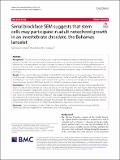Files in this item
Serial blockface SEM suggests that stem cells may participate in adult notochord growth in an invertebrate chordate, the Bahamas lancelet
Item metadata
| dc.contributor.author | Holland, Nicholas D. | |
| dc.contributor.author | Somorjai, Ildiko M.L. | |
| dc.date.accessioned | 2020-11-02T16:30:08Z | |
| dc.date.available | 2020-11-02T16:30:08Z | |
| dc.date.issued | 2020-10-17 | |
| dc.identifier | 271010680 | |
| dc.identifier | e9ed16cc-6e5c-4224-a8f4-5271661b79f9 | |
| dc.identifier | 85092741801 | |
| dc.identifier | 000579268800001 | |
| dc.identifier.citation | Holland , N D & Somorjai , I M L 2020 , ' Serial blockface SEM suggests that stem cells may participate in adult notochord growth in an invertebrate chordate, the Bahamas lancelet ' , EvoDevo , vol. 11 , 22 . https://doi.org/10.1186/s13227-020-00167-6 | en |
| dc.identifier.other | ORCID: /0000-0001-5243-6664/work/83085995 | |
| dc.identifier.uri | https://hdl.handle.net/10023/20886 | |
| dc.description | Funding: Lancelet research at Scripps Institution of Oceanography is supported by NSF Grant IOS 1952567 to LZ Holland and ND Holland. Research in the Somorjai lab is funded by Wellcome Trust ISSF3 and EU Horizon 2020 grants INFRADEV4 [654248] and INFRA ASSEMBLE [930984]. | en |
| dc.description.abstract | Background : The cellular basis of adult growth in cephalochordates (lancelets or amphioxus) has received little attention. Lancelets and their constituent organs grow slowly but continuously during adult life. Here, we consider whether this slow organ growth involves tissue-specific stem cells. Specifically, we focus on the cell populations in the notochord of an adult lancelet and use serial blockface scanning electron microscopy (SBSEM) to reconstruct the three-dimensional fine structure of all the cells in a tissue volume considerably larger than normally imaged with this technique. Results : In the notochordal region studied, we identified 10 cells with stem cell-like morphology at the posterior tip of the organ, 160 progenitor (Müller) cells arranged along its surface, and 385 highly differentiated lamellar cells constituting its core. Each cell type could clearly be distinguished on the basis of cytoplasmic density and overall cell shape. Moreover, because of the large sample size, transitions between cell types were obvious. Conclusions : For the notochord of adult lancelets, a reasonable interpretation of our data indicates growth of the organ is based on stem cells that self-renew and also give rise to progenitor cells that, in turn, differentiate into lamellar cells. Our discussion compares the cellular basis of adult notochord growth among chordates in general. In the vertebrates, several studies implied that proliferating cells (chordoblasts) in the cortex of the organ might be stem cells. However, we think it is more likely that such cells actually constitute a progenitor population downstream from and maintained by inconspicuous stem cells. We venture to suggest that careful searches should find stem cells in the adult notochords of many vertebrates, although possibly not in the notochordal vestiges (nucleus pulposus regions) of mammals, where the presence of endogenous proliferating cells remains controversial. | |
| dc.format.extent | 15 | |
| dc.format.extent | 3818051 | |
| dc.language.iso | eng | |
| dc.relation.ispartof | EvoDevo | en |
| dc.subject | Amphioxus | en |
| dc.subject | Cephalochordata | en |
| dc.subject | Intervertebral disc | en |
| dc.subject | Lancelet | en |
| dc.subject | Notochord | en |
| dc.subject | Nucleus pulposus | en |
| dc.subject | Progenitor cell | en |
| dc.subject | Serial blockface scanning electron microscopy (SBSEM) | en |
| dc.subject | Stem cell | en |
| dc.subject | QH301 Biology | en |
| dc.subject | Ecology, Evolution, Behavior and Systematics | en |
| dc.subject | Developmental Biology | en |
| dc.subject | Genetics | en |
| dc.subject | NDAS | en |
| dc.subject.lcc | QH301 | en |
| dc.title | Serial blockface SEM suggests that stem cells may participate in adult notochord growth in an invertebrate chordate, the Bahamas lancelet | en |
| dc.type | Journal article | en |
| dc.contributor.sponsor | The Wellcome Trust | en |
| dc.contributor.sponsor | European Commission | en |
| dc.contributor.sponsor | European Commission | en |
| dc.contributor.institution | University of St Andrews. Centre for Biophotonics | en |
| dc.contributor.institution | University of St Andrews. Biomedical Sciences Research Complex | en |
| dc.contributor.institution | University of St Andrews. Marine Alliance for Science & Technology Scotland | en |
| dc.contributor.institution | University of St Andrews. School of Biology | en |
| dc.identifier.doi | 10.1186/s13227-020-00167-6 | |
| dc.description.status | Peer reviewed | en |
| dc.identifier.grantnumber | en | |
| dc.identifier.grantnumber | 654248 | en |
| dc.identifier.grantnumber | 730984 | en |
This item appears in the following Collection(s)
Items in the St Andrews Research Repository are protected by copyright, with all rights reserved, unless otherwise indicated.

